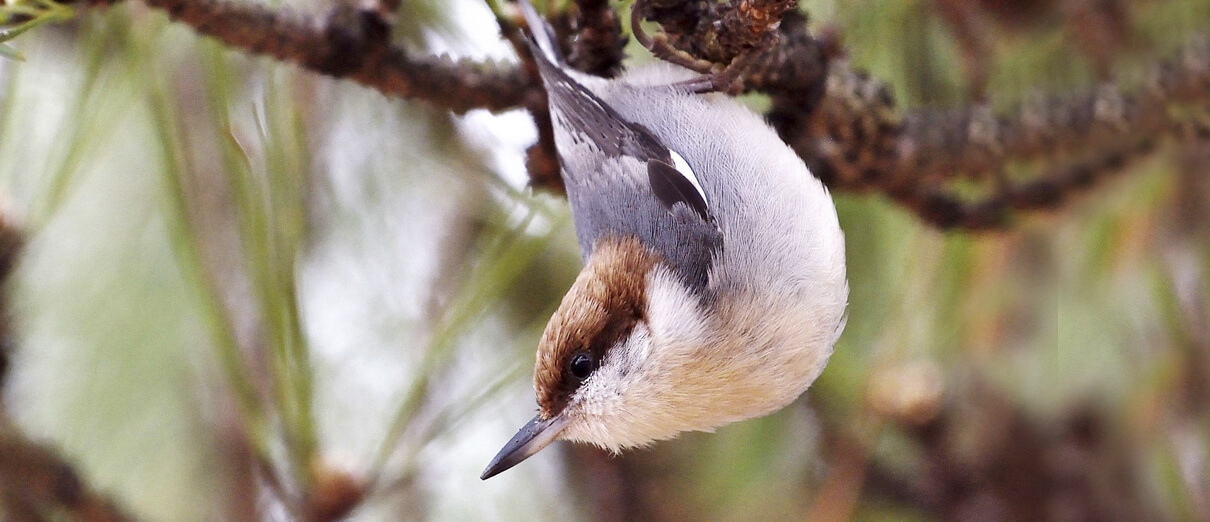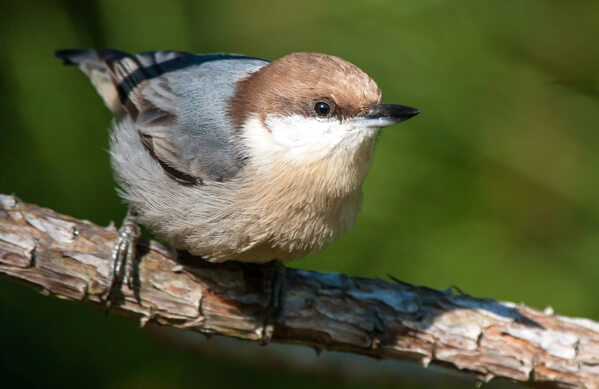
Brown-headed Nuthatch range map by American Bird Conservancy
The perky, social Brown-headed Nuthatch never strays far from its favorite pine-forest habitat, where small flocks range through the trees, easily detected by their squeaky calls. Even smaller than its close relative the White-breasted Nuthatch, it's no wonder that this tiny songbird's species name is pusilla, Latin for "very small."
Tiny Tool-User
The Brown-headed Nuthatch, like the Green Heron, is one of the few birds in the world known to regularly use tools. When foraging, it may select a flake of pine bark, then use it as a lever to pry up bark scales to get at food hidden beneath, usually insects and spiders or their eggs. This enterprising little bird has also been observed using twigs and pine needles as tools. A Brown-headed Nuthatch will even carry its tool from tree to tree as it forages, or use it to cover up a cache of seeds.
Hacking and Hammering
The name “nuthatch” derives from an Old English word, “nut-hack,” that describes an unusual feeding method shared by all nuthatch species. These birds wedge their food — nuts, seeds, or invertebrates — into bark crevices, then hammer or "hack" at the food with their bills to open it or tear it apart.
Like other nuthatches, the Brown-headed Nuthatch wanders around and up and down tree trunks and branches as it searches for food, sometimes even hanging upside down like a Tufted Titmouse. This species also caches seeds, like other resident (nonmigratory) species, such as the Black-capped Chickadee and Downy Woodpecker. Brown-headed Nuthatches often visit backyard bird feeders for suet and seed.
Pine-Forest Specialist
The Brown-headed Nuthatch is found in much of the southeastern United States where pines predominate, from the southeastern corner of Oklahoma and eastern Texas across central Arkansas and Louisiana, skipping Mississippi River lowlands. The bird's range continues from eastern Louisiana and Mississippi across the Piedmont and Coastal Plain of the Eastern Seaboard's southeastern states and extends as far north as Maryland's Eastern Shore and southern Delaware.
No Brown-headed Nuthatch subspecies are recognized. A distinct population found on Grand Bahama island, not far off Florida's Atlantic coast, was declared a separate species, the Bahama Nuthatch. Following 2019's Hurricane Dorian, this Critically Endangered species is now feared extinct. Similar concerns were raised after Hurricane Matthew in 2016, although a few birds were rediscovered in 2018. It was thought at the time that the population contained fewer than ten birds.
The most common call of the Brown-headed Nuthatch, a high-pitched, squeaky chee-da, recalls the sound of air escaping a squeeze-toy. Together, a vocalizing flock of Brown-headed Nuthatches sounds like a small flotilla of rubber duckies.
(Audio of Brown-headed Nuthatch by Andrew Spencer, XC102138. Accessible at www.xeno-canto.org/102138)
Pair-bonding in the Pines
Brown-headed Nuthatches form strong pair bonds, which may endure for several years and even last the birds' lifetimes. The male chooses a nest site, usually in a well-rotted branch or other natural cavity, an old woodpecker hole, or sometimes a nest box. Both birds bring bark shreds, wood chips, grass, and other soft materials to the cavity, where the female lays three to nine eggs. This species begins to nest early in the spring, so is often able to successfully raise a second brood.
Like the Pinyon Jay and Acorn Woodpecker, the Brown-headed Nuthatch is a cooperative breeder, with "helper" birds, usually young males from previous broods, remaining nearby to help their parents with nest-building or feeding the incubating female and newly hatched nestlings.

Brown-headed Nuthatch by Habib Mahmud/Shutterstock
Habitat Loss and Gain
The biggest threat to the Brown-headed Nuthatch is habitat loss, particularly of mature pine woods and snags. In many parts of the South, the vast, open-canopy pine woodlands that once supported large populations of nuthatches and other birds such as the Northern Bobwhite and Red-headed Woodpecker are now being restored both for timber production and wildlife value. Management practices that favor these birds include reducing hardwoods that can out-complete pines and thinning pines to allow more light to reach the forest floor. Prescribed fire following thinning suppresses the growth of hardwood trees and encourages regeneration of the pines, as well as understory plants that provide food and cover for the nuthatches.
ABC's work with the Sustainable Forestry Initiative is helping to inform forest management practices that benefit both birds and landowners. These efforts maintain habitat for birds such as the Prairie Warbler, Red-cockaded Woodpecker, Swallow-tailed Kite, and Brown-headed Nuthatch. Learn more about ABC's work with SFI.
The Brown-headed Nuthatch can benefit from reintroduction efforts. An extirpated population was successfully re-established on Long Pine Key in Florida's Everglades National Park beginning in 1997, and in 2020, 46 Brown-headed Nuthatches from Arkansas were released into habitat restored by ABC and partners within Missouri's Mark Twain National Forest, about a century after the species' extirpation in that state.
Donate to support ABC's conservation mission!



















































